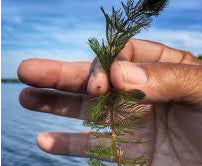
There are certain positive sides of having algae and weeds in a pond, as the feeding of fish and filtration among others. But when the population goes beyond limits, the weeds and algae can block the sunlight, consume the available resources and oxygen (thereby causing the death of other plants and animals), deteriorate the beauty of the pond and may also be a cause of other drawbacks as well. Many people and pond owners, and even the government authorities may be disturbed by the weed problem. But because there are various nuances involved, a good aquatic weed control approach would accommodate the different variables.
Preventive Measures
The pond weeds may flourish when they get to grow favorable roots in the soil. You can prevent the problem by creating the steeper banks on the pond’s edge. This way the plants will not be able to hold roots. But the measure will not prevent the growth of floating plants and algae.
The weed and algae population may also proliferate when the nutrients get flooded into the pond from the surrounding soil (for instance inflow of the fertilizers). You can plant trees or natural plants (for a certain feet distance) between the pond and the fertilized land, thereby creating a buffer zone. This way the nutrients from surrounding soil will not enter into the pond. Animal waste, animal feed, and livestock should also be kept away from the pond. For attaining the objective you can create a fence or use other measures. Also, remember that you should act fast whenever you witness a significant weed issue.
Weed Removal
The best pond management service providers and professionals will carry an onsite evaluation to identify the problematic species, for proper aquatic weed control. Identification ensures that time and resources are not wasted and specific measures are adapted for controlling the weed population. The identification may involve the use of stereoscopes, dichotomous keys, and lab tests.
Henceforth, the employed method of weed removal depends on the kind of weed and the extent of population growth. Nutrient management and remediation products including Biochar and Alum restore the balanced composition of the pond and improve water quality. Biological control methods include the use of triploid grass carp fish that have a great appetite for a range of aquatic plants. In certain situation, dredging hydro raking, and other methods of extensive sedimentation and vegetation removal may be required.
Use of Herbicides
A herbicide should be chosen carefully in lieu of the targeted weed. Herbicides nowadays come in many different forms, including granules, sprays, liquids, and solid forms. When you have to control the population of algae, you may require the copper chelates and the copper sulfates. For the submerged plants (including the free-floating plants like duckweed) Fluridone or Diquat may be required.
There are also “reduced risk” aquatic herbicides available (including Procella COR) that will target only the target species. It is important to choose a herbicide to target a given and specific population, and you may need to hire and work with professionals who have proper expertise and resources.
Stake Holder Desires
Different stakeholders will have different goals and desires for their pond health. For instance, a homeowner association’s aspirations may vastly differ from those of an owner of a duck hunting and fishing pond. Therefore, your desires and vision should be properly communicated to the pond management professionals. There may also instances when there might be more than one stakeholder, and in these situations, more careful evaluation of the goals may be required.
Read what our customers have to say about our products:
Review for Harvester Liquid
“Excellent Product. Worked very quickly, and did a wonderful job."
- Warren R.
